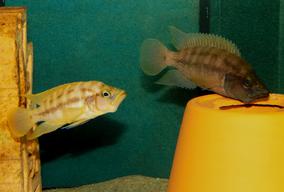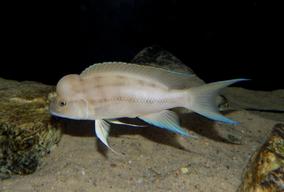Rarer representatives of the genus Neolamprologus
They usually reach a size of about 10-15 cm and are found throughout the lake in rocky zones, where they feed on plankton, crustaceans, and fry. Most species live in pairs, a smaller part solitary, and pairs are formed only for the purpose of reproduction. Representatives of this genus are among the relatively frequently kept Tanganyika fish, but not all representatives are common and easy to breed. In this article, I would like to focus on three representatives of this extensive genus, which are less common in Czech and foreign aquariums.
Neolamprologus bifasciatus (Büscher, 1993)
This species occurs throughout Lake Tanganyika, and fish from different locations do not differ much in appearance. The fish live on the border of rocky and sandy parts of the lake at a depth of about 30 m and are not among the most abundant. Their occurrence is rather sporadic. Their food consists mainly of crustaceans and insect larvae. Males grow to about 10 cm, females 7 cm. To keep these fish, water with a temperature of around 24-26 °C, a nitrate level below 30 mg/l and a pH of 8 or higher is sufficient. For feeding, I most often provide live or frozen plankton, artemia, cyclops, mosquito larvae, and high-quality flake food. The fish form very strong pairs, and pairing them can easily (even in a really large tank) end with the death of weaker individuals. For pairing, a tank at least 150 cm long is ideal, equipped with as many hiding places as possible. For starters, you should buy at least 6 fish, preferably more. For the pair itself, a tank with a capacity of 100 l or more is sufficient, also equipped with a large number of hiding places. These fish are not among the fertile species. The most common number of eggs is about 10. We feed the free-swimming fry with artemia or fine plankton. The aquarist usually notices the presence of fry only when they are larger. The smallest fry are hidden in crevices and move very inconspicuously on the sand. At the slightest movement in front of the tank, they hide on the bottom, where they blend in perfectly, which, combined with the low number of spawns, means that they are very easily overlooked. This interesting species will probably never be very widespread, because in addition to high aggression and low fertility, it is also characterized by the fact that it does not show much willingness to reproduce in captivity.
Neolamprologus longicaudatus (Nakaya & Gashagaza, 1995)
The adult male of this species grows to about 15 cm, the female 10 cm. The adult male has a distinct fatty hump on his head. This species occurs at a depth of 10-25 m. Two color forms are known - from the Kavala location, the fish are darker, from the Ubwari location, they are lighter. This species probably occurs only between these two locations, which are about 200 km apart. The food of these fish is similar to that of other members of the genus and consists mainly of invertebrates and occasionally the fry of other fish. For keeping, water with a temperature of around 24-26 °C, a nitrate level below 30 mg/l and a pH of 8 or higher is needed. For feeding, I most often provide live or frozen plankton, artemia, and high-quality flake food. Adult fish will not disdain good granules or pieces of fish meat either. For one pair, you need a tank with an edge of at least 150 cm, which we equip with a large number of hiding places. In a larger tank, over 250 cm, you can keep a trio. The fish do not form permanent pairs. The female defends a selected territory, and the male freely swims through the territories of the females, which he does not pay attention to outside of spawning. However, this does not apply to relations between males. Here the aggression is really high, and considering the size of the males, it is not possible to keep more than one in a standard-sized tank for a long time. The female guards the spawn in her territory, which usually numbers 20-50 eggs, and protects the fry up to a size of about 3 cm. Then the fry are gradually displaced from the territory. Growth is relatively fast, and raising them with plankton and artemia is not a problem.
Neolamprologus prochilus (Bailey & Stewart, 1977)
In terms of appearance, it is a very specific representative of the genus. The fish have an elongated, angular head, on which large pores are clearly visible, necessary for hunting in rocky, deeper waters, where there is little light. They are predators that feed on small invertebrates, but will not disdain fry either. The male grows to about 14 cm, the female 9 cm. They occur throughout the lake at a depth of 30 m and more, often in the company of a similar species, Neolamprologus obscurus. Fish from different locations hardly differ. Adult fish live solitary lives. Pairs are formed only for the purpose of reproduction. For keeping in an aquarium, as with other members of the genus, water with a temperature of 24-26 °C and a pH of 8 or higher is needed. They are not very sensitive to nitrates. It is enough to keep them below 30 mg/l. They live solitary lives and are relatively large fish. For keeping, you need a tank with a capacity of at least 150 l with a large number of hiding places, preferably those that cannot be seen from the front glass. This is because it is a rather shy and skittish species. They do not form permanent pairs, but you still need to choose fish that will tolerate each other in the tank. For pairing, a larger tank with a large number of hiding places is optimal. The diet of these fish is strictly frozen and live and consists of plankton, artemia, cyclops, and mosquito larvae. Adult fish refuse to take flakes or do so with obvious reluctance. These fish reach sexual maturity at the age of 3 years. In nature, they reportedly lay about 50 eggs. In my aquarium, they most often lay about 20 eggs. The female guards the spawn only until the fry swim freely, then the fry move very secretively around the tank, and the parents ignore them. However, until they are caught, another spawn does not take place. I catch the fry at a size of about 1 cm, and raising them with plankton is not a problem. Growth is very slow, comparable to representatives of the genus Altolamprologus.
List of photos:
- Prochilus male
- Prochilus male
- Prochilus pair
- Longicaudatus Ubwari female
- Longicaudatus Ubwari male
- Longicaudatus Ubwari male
- Bifasciatus pair
Literature used:
- Tanganyika cichlids in their natural habitat, Ad Konings, Cichlid Press, 1998
- Tanganjika buntbarsche (Second edition), Ad Konings, Dähne Verlag GmbH, 2005














